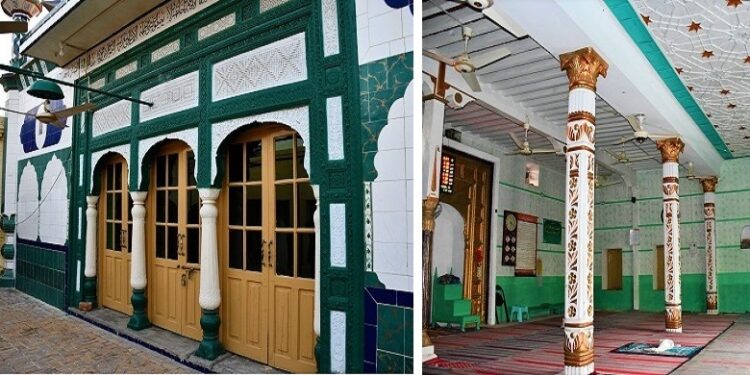
Hindu community was in majority in Thatta village before partition whereas the Muslim community was in minority.
Zulfiqar Ali Kalhoro
Thatta is a historical village in Jand tehsil in the Attock district. It is located about 7 km north of Mithial Chowk in Jand tehsil. The present village of Thatta was founded for the fifth time in the 17th century by Baba Muhammad Ali Khan Khattar. This village is noted for its imposing havelis and magnificent mosques. The earliest mosques in Thatta village were built in the 17th and 18th centuries. According to the Gazetteer of the Attock district in 1930 that Thatta and Nara villages in then Pindiheb tehsil were the homes of Hindu bankers with an all-India reputation. According to Muhammad Javed Iqbal Khattar, the Numbardar of Thatta village Hindu community was in majority in Thatta village before partition whereas the Muslim community was in minority.
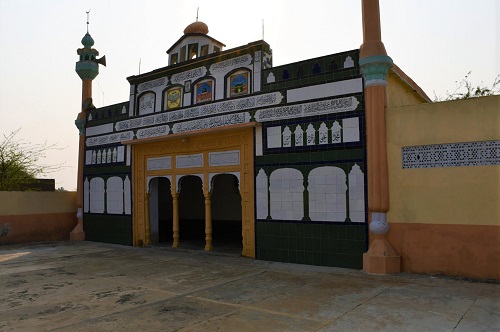
There are several mosques in Thatta village which include Masjid Abu Bakr, Bangala Masjid, Masjid, Qazi, Ustad Majeed Masjid, Bilal Masjid, Jabar Masjid, Jamia Masjid, Rukh Wali Masjid, Tanki Wali Masjid, Langar Khana Masjid, and others. Of these, the Tanki Wali Masjid, Langar Khana Masjid, Jamia Masjid, and Rukh wali Masjid are the oldest historical mosques in Thatta village.
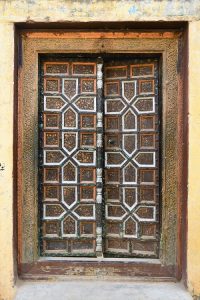
Mian Muhammad Shafi, who is an 82-year-old oral historian and Ustad (teacher) at the Jamia mosque of Thatta village, is the most knowledgeable person who knows about mosques, havelis – and Hindu and Muslim merchants of pre-partition Thatta. I will write about the havelis and Hindu merchants of Thatta village in another article. Mian Muhammad Shafi believes that the first mosque in Thatta village, which is called Pipal Wali Masjid alias Tanki wali Masjid, was built by Mian Khan Khattar, the eldest son of Baba Muhammad Ali Khan Khan who was the ancestor of all Khattars of Thatta. Baba Muhammad Ali Khan had five sons Mian Khan, Khan Mulkh, Noor Khan, Fateh Khan, and Dara Khan after whom Mian Khani, Mulkhial, Noor Khani, and Fateh Khani lineages are named. Dara Khan died without any issue.
Pipal Wali Masjid, now known as Tanki Wali Masjid, was built by Mian Khan Khattar in the 17th century and was noted for woodwork and paintings. Masons from the Jandal area in Jand tehsil were employed to build the mosque. The Jandal area comprises 13 villages – Nara, Nathiyal, Parri, Kundrala, Pindi Sirhal, Pind Sultani, Garhi, Basal, Mithial, Kahal, Domel, Thatta, and Saghri. Jandali masons and merchants were known for their skilled work and business. All the old mosques in Jandal area were constructed of stone. Now the majority of the mosques have either been renovated or rebuilt. However, there are a few villages where one can see the mastery of Jandali craftsmanship. One such village is Thatta, which is famous not only for mosques but also for impressive havelis. The majority of the havelis have either been renovated or rebuilt.

Tanki Wali Masjid was demolished a few years ago and in its stead a new mosque was built. I visited this mosque in March 2021, when it was under construction. I observed a few wooden pillars which were used in the payer hall of the mosque. The same wooden pillars were also used in the ablution area of the mosque. The second oldest mosque in Thatta village is Rukh Wali Masjid which is believed to have been built by Khan Mulkh, the son of Baba Muhammad Ali Khan Khattar as told by Muhammad Javed Iqbal the Numbardar of Thatta village. This mosque has lost its originality due to frequent renovations. From this mosque, one has a commanding view of the Thatta village.
The third oldest mosque is Langar Khana Masjid which was formerly known as Dhibbey Wali Masjid. It is located northwest of Rukh Wali Masjid which was believed by a grandson of Baba Muhammad Ali Khan Khattar. He was named after his grandfather Muhammad Ali Khan II. The Langar Khana mosque is famous for its beautiful woodwork. It has also been renovated a few times. However, it has retained its original woodwork. The mosque is built on a rectangular plan. Three wooden arched entrances open to the antechamber of the mosque. The wooden door of the mosque opens to the main prayer hall. Both arched entrances and doors are ornately carved. Both floral and geometric designs are engraved on the wooden door of the mosque. The antechamber of the mosque has a wooden ceiling. All woodwork in the mosque is aesthetically painted. The masons of Thatta village and other villages in the Jandal area built and renovated the Langar Khana mosque. This reflects how skilled and accomplished the artists and craftsmen of the Jandal area were. The arts and crafts of the Jandal area have their own beauty, elegance, and identity. Floral and geometric designs on the wooden doors and ceilings of mosques in the Thatta village area show the mastery of Jandali craftsmen over the art of wood carvings.
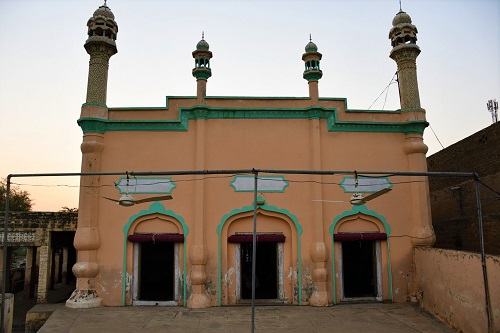
The fourth old and historical mosque is the Jamia mosque, which is also known as Bazaar Wali mosque, as it is located in the historic Thatta bazaar – where one can still see a few old shops with wooden doors dating to the pre-Partition period.
One enters through a wooden carved door into the courtyard of the mosque. It is a rectangular mosque with three wooden arched entrances leading to the main prayer hall of the mosque. Formerly, the main chamber hall of the mosque was separated by the eastern wall of the antechamber which was removed during the renovation and expansion of the mosque. A wooden carved door which was fixed in the eastern wall of the antechamber to the main prayer hall was also removed. The wooden frame of the door was reused in the mihrab of the mosque whereas the door shutters were used in the main entrance of the mosque. The distinctive features of the Jamia mosque of Thatta village are the carved wooden doors and pillared hall. Nowhere else in the Jandal area in Jand tehsil in Attock district is found a mosque with such wooden pillars.
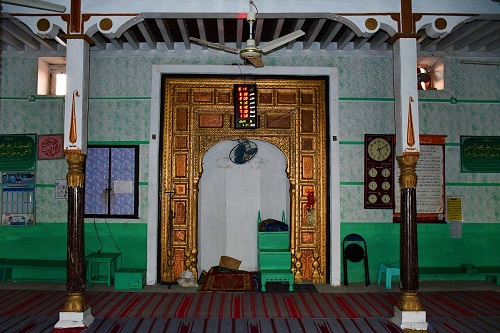
A beam-and-pillar technique was adopted to construct the main hall of the mosque. The roof of the main prayer hall rests on four wooden pillars. All the pillars have fluted shafts that rest on a stylized square base. Two central wooden pillars which support the wooden roof of the mosque, are decorative. Four more columns were added when the eastern wall of the antechamber was removed during a renovation of the mosque. The two central wooden pillars are located just in front of the mihrab which is now decorated with a wooden frame. Both pillars are noted for decorative volutes and the engraving of a cypress tree which is a recurrent motif in Islamic Art. Apart from the Jamia mosque, one can see wooden pillars in the Jamia mosque of Maira Sharif in Pindigheb and the Jamia mosque of Chawli village in Chakwal district.
The Jamia mosque of Thatta is also noted for its beautiful wooden ceiling. Both the main payer hall and ablution area are covered with wooden ceilings. The wooden ceiling of the ablution area was removed during a renovation. I saw the wooden ceiling of the ablution area in March 2021 when it was extant.
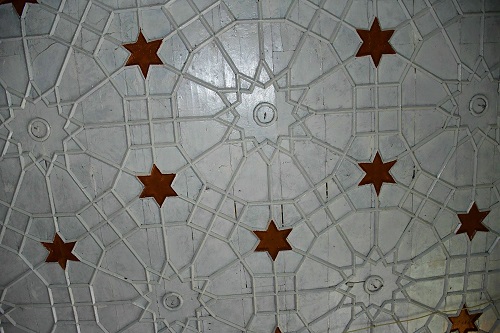
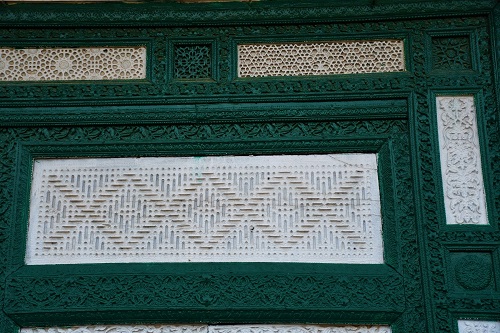
One does not find such remarkable wooden ceilings in any other mosque in Thatta village. I have not seen such an impressive wooden ceiling elsewhere in Jand tehsil in the Attock district. However, one can see more imposing painted wooden ceilings in the shrine complexes of Moulana Muhammad Ali Makhadi (1750-1737) and Syed Nuri Badshah in Makhad village in Jand tehsil.
All four historical mosques were built by descendants of Baba Muhammad Ali Khan Khattar and are noted for woodwork and masonry, which was removed during the renovation or rebuilding of the mosque. However, two of the mosques, the Jamia Mosque and Langar Khana Mosque, have still retained their original woodwork which should be preserved by the authorities concerned for posterity.
___________________
 Dr. Zulfiqar Ali Kalhoro, an anthropologist, has authored 12 books: ‘Symbols in Stone: The Rock Art of Sindh’, ‘Perspectives on the art and architecture of Sindh’, ‘Memorial Stones: Tharparkar’ and ‘Archaeology, Religion and Art in Sindh’. He may be contacted at: zulfi04@hotmail.com
Dr. Zulfiqar Ali Kalhoro, an anthropologist, has authored 12 books: ‘Symbols in Stone: The Rock Art of Sindh’, ‘Perspectives on the art and architecture of Sindh’, ‘Memorial Stones: Tharparkar’ and ‘Archaeology, Religion and Art in Sindh’. He may be contacted at: zulfi04@hotmail.com
Courtesy: The Friday Times Naya Daur Lahore (Published on October 22, 2022)